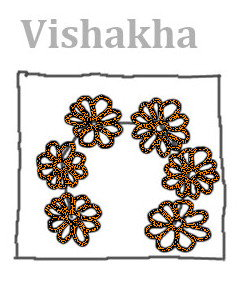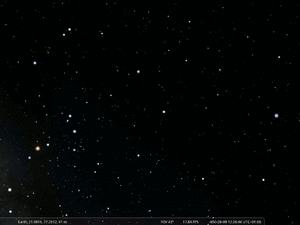Vishakha: Difference between revisions
No edit summary |
No edit summary |
||
| (7 intermediate revisions by the same user not shown) | |||
| Line 1: | Line 1: | ||
{{DISPLAYTITLE:}} |
{{DISPLAYTITLE:Viśākhā (विशाखा)}} |
||
[[File:Vishakha nakshatras in Temple draw+lbl 4ase.jpg|thumb|Vishakha, , 16th nakshatra, ...]] |
|||
[[File:16 Vishakha stellarium.gif|thumb|Vishakha, the 16th nakshatra, mapped to the Stellarium star chart (WGSN 2025).]] |
|||
... is an Indian name, used by the Indian Vedic tradition. Most of these names are roughly 3000 years old. They pre-date Hinduism but were taken over by it. |
|||
Viśākhā (विशाखा), "forked", is an Indian name, used by the Indian Vedic tradition. Most of these names are roughly 3000 years old. They pre-date Hinduism but were taken over by it. Identified with α, β, γ and ι Librae. |
|||
==Etymology and History== |
==Etymology and History== |
||
'''Name Variants''' |
|||
[[File:Tibet nakshatra 14.png|thumb|Tibet nakshatra 14]] |
|||
* Viśākhā, |
|||
The name "Vishakha" means "having many branches" which is depicted in the temple drawing. Yet, the asterism has only four stars among which two are α and β Librae which is known from coordinates. The other two are typically identified with ι and γ Lib. These four stars do not form a line but a quadrilateral in the sky. It is outside the band of the Milky Way. Therefore, the literal translation may not refer to any recognizable pattern (of stars or bright or dark clouds of the Milky Way). |
|||
* Vishakha |
|||
* Dvidaivata |
|||
===Origin of Constellation=== |
===Origin of Constellation=== |
||
The name "Vishakha" means "having many branches" which is depicted in the temple drawing. Yet, the asterism has only four stars among which two are α and β Librae which is known from coordinates. The other two are typically identified with ι and γ Lib. These four stars do not form a line but a quadrilateral in the sky. It is outside the band of the Milky Way. Therefore, the literal translation may not refer to any recognizable pattern (of stars or bright or dark clouds of the Milky Way). |
|||
====Stars within the Constellation Area==== |
|||
{| class="wikitable sortable mw-collapsible" |
|||
|+ |
|||
|- |
|||
!id |
|||
!Label |
|||
!IAU design. |
|||
! description |
|||
!Vmag |
|||
|- |
|||
|1 |
|||
|Zubeneschamali |
|||
|HIP 74785 |
|||
|Constellation lines (Vertex) |
|||
|2.62 |
|||
|- |
|||
|2 |
|||
|Zubenelgenubi |
|||
|HIP 72622 |
|||
|Constellation lines (Vertex) |
|||
|2.75 |
|||
|- |
|||
| 3 |
|||
|μ Virginis |
|||
|HIP 71957 |
|||
|Constellation lines (Vertex) |
|||
|3.88 |
|||
|- |
|||
|4 |
|||
|Kang |
|||
|HIP 69427 |
|||
|Constellation lines (Vertex) |
|||
|4.21 |
|||
|- |
|||
|5 |
|||
|16 Lib |
|||
|HIP 73165 |
|||
|Constellation lines (Vertex) |
|||
|4.49 |
|||
|- |
|||
|6 |
|||
| Khambalia |
|||
|HIP 69974 |
|||
|Constellation lines (Vertex) |
|||
|4.52 |
|||
|- |
|||
|7 |
|||
|δ Librae |
|||
|HIP 73473 |
|||
|Inside the hull |
|||
|4.93 |
|||
|- |
|||
|8 |
|||
|α 1 Librae |
|||
| HIP 72603 |
|||
|Inside the hull |
|||
|5.16 |
|||
|- |
|||
|9 |
|||
|μ Librae |
|||
|HIP 72489 |
|||
|Inside the hull |
|||
|5.31 |
|||
|- |
|||
|10 |
|||
|ξ 2 Librae |
|||
|HIP 73133 |
|||
|Inside the hull |
|||
| 5.45 |
|||
|- |
|||
|11 |
|||
| * mu. Lib A |
|||
|HIP 72489 |
|||
|Inside the hull |
|||
|5.6 |
|||
|- |
|||
|12 |
|||
|ξ 1 Librae |
|||
| HIP 72934 |
|||
|Inside the hull |
|||
|5.788 |
|||
|- |
|||
| 13 |
|||
|18 Lib |
|||
|HIP 73310 |
|||
|Inside the hull |
|||
|5.857 |
|||
|- |
|||
| 14 |
|||
| - |
|||
|HIP 73309 |
|||
|Inside the hull |
|||
|6.08 |
|||
|- |
|||
|15 |
|||
| - |
|||
|HIP 71469 |
|||
| Inside the hull |
|||
|6.2 |
|||
|- |
|||
|16 |
|||
|2 Lib |
|||
|HIP 70336 |
|||
|Inside the hull |
|||
|6.214 |
|||
|- |
|||
|17 |
|||
| - |
|||
|HIP 72373 |
|||
|Inside the hull |
|||
|6.32 |
|||
|- |
|||
|18 |
|||
|5 Lib |
|||
|HIP 72194 |
|||
|Inside the hull |
|||
| 6.34 |
|||
|- |
|||
|19 |
|||
| - |
|||
|HIP 73571 |
|||
|Inside the hull |
|||
|6.373 |
|||
|- |
|||
|20 |
|||
| - |
|||
| HIP 70501 |
|||
|Inside the hull |
|||
|6.49 |
|||
|} |
|||
===Transfer and Transformation of the Constellation=== |
===Transfer and Transformation of the Constellation=== |
||
<gallery> |
|||
File:Vishakha nakshatras in Temple draw+lbl 4ase.jpg|Vishakha, 10th century |
|||
File:Tibet nakshatra 14.png|Vishakha, Tibetean |
|||
File:氐宿(仏像図彙).png|Vishakha, Chinese |
|||
File:16 Vishakha draw.png|reconstructed by Jones (1720) |
|||
</gallery> |
|||
==Mythology== |
==Mythology== |
||
| Line 28: | Line 168: | ||
[[Category:Eurasia]] |
[[Category:Eurasia]] |
||
[[Category:South Asian]] |
[[Category:South Asian]] |
||
[[Category:Zodiac]] |
|||
Latest revision as of 17:19, 14 December 2025
Viśākhā (विशाखा), "forked", is an Indian name, used by the Indian Vedic tradition. Most of these names are roughly 3000 years old. They pre-date Hinduism but were taken over by it. Identified with α, β, γ and ι Librae.
Etymology and History
Name Variants
- Viśākhā,
- Vishakha
- Dvidaivata
Origin of Constellation
The name "Vishakha" means "having many branches" which is depicted in the temple drawing. Yet, the asterism has only four stars among which two are α and β Librae which is known from coordinates. The other two are typically identified with ι and γ Lib. These four stars do not form a line but a quadrilateral in the sky. It is outside the band of the Milky Way. Therefore, the literal translation may not refer to any recognizable pattern (of stars or bright or dark clouds of the Milky Way).
Stars within the Constellation Area
| id | Label | IAU design. | description | Vmag |
|---|---|---|---|---|
| 1 | Zubeneschamali | HIP 74785 | Constellation lines (Vertex) | 2.62 |
| 2 | Zubenelgenubi | HIP 72622 | Constellation lines (Vertex) | 2.75 |
| 3 | μ Virginis | HIP 71957 | Constellation lines (Vertex) | 3.88 |
| 4 | Kang | HIP 69427 | Constellation lines (Vertex) | 4.21 |
| 5 | 16 Lib | HIP 73165 | Constellation lines (Vertex) | 4.49 |
| 6 | Khambalia | HIP 69974 | Constellation lines (Vertex) | 4.52 |
| 7 | δ Librae | HIP 73473 | Inside the hull | 4.93 |
| 8 | α 1 Librae | HIP 72603 | Inside the hull | 5.16 |
| 9 | μ Librae | HIP 72489 | Inside the hull | 5.31 |
| 10 | ξ 2 Librae | HIP 73133 | Inside the hull | 5.45 |
| 11 | * mu. Lib A | HIP 72489 | Inside the hull | 5.6 |
| 12 | ξ 1 Librae | HIP 72934 | Inside the hull | 5.788 |
| 13 | 18 Lib | HIP 73310 | Inside the hull | 5.857 |
| 14 | - | HIP 73309 | Inside the hull | 6.08 |
| 15 | - | HIP 71469 | Inside the hull | 6.2 |
| 16 | 2 Lib | HIP 70336 | Inside the hull | 6.214 |
| 17 | - | HIP 72373 | Inside the hull | 6.32 |
| 18 | 5 Lib | HIP 72194 | Inside the hull | 6.34 |
| 19 | - | HIP 73571 | Inside the hull | 6.373 |
| 20 | - | HIP 70501 | Inside the hull | 6.49 |
Transfer and Transformation of the Constellation
Mythology
mnemonic tales and cultural significance
Weblinks
References
- References (general)










